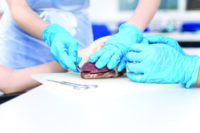Introduction
Popcorn is one of the world’s favorite snack foods. In the US, Americans consume as much as 18 billion quarts of popcorn each year, which equates to 56 quarts per person. Some nutritionists call it a perfect snack food because it is a whole grain, a good source of fiber, and low in fat. One study even claims there are more antioxidants in popcorn than in some fruits and vegetables.1
Background
The most intriguing part of popcorn is the science behind how it pops. Popcorn is the only grain in the corn family that pops open when exposed to temperatures above 180° C. A popcorn kernel is composed of 3 parts: the pericarp, germ, and endosperm. See Fig. 1.
The pericarp is the tough outer shell surrounding a popcorn kernel, and the key to what makes it pop. Inside the pericarp is the germ, or seed embryo. Adjacent to the germ is the endosperm, which contains some trapped water plus soft and hard starch granules that serve as food for the germ when it sprouts.
When a popcorn kernel is heated, the trapped water in the endosperm turns into steam, building up pressure inside the pericarp. This pressurized, super-heated steam transforms the soft starch in the endosperm into a gelatinous material. Popcorn pericarp is much stronger than that of all other corn kernels and is able to retain this pressurized steam up to 9.2 atm (135 psi).
Above that pressure, the pericarp ruptures, releasing the steam and gelatinous starch that solidifies upon cooling. The resulting popped kernel is 40 to 50 times its original size.

People often wonder what is the ideal percentage of water in popcorn kernels for best popping. Popcorn is harvested in the fall when the kernels’ moisture content is between 16 and 20%. The kernels are then stored in bins where they are dried by forced air until reaching an optimum moisture level of 14%. If the moisture content drops below that value, the size of the popped kernels is smaller and the number of kernels that pop decreases.
Inquiry activity
Popcorn is a great real-world example to use when discussing the kinetic molecular theory of gases, the phase change of water from a liquid to a gas, Gay-Lussac’s gas law (pressure directly related to temperature), and the ideal gas law (PV = nRT). After covering the gas laws in class, complement the lesson with an inquiry activity using several brands of popcorn. Have student lab groups devise a lab procedure to determine the following and submit it for your approval:
- Determine the % of water by weight for 20 kernels of each brand.
- Determine the internal pressure in atmospheres (atm) needed for each of the 20 kernels to pop. Hint: Use the ideal gas law, PV = nRT. Solve for P, which will be pressure in atm.
The other values in the equation will be:- n = Moles of water lost (g water lost after popping ÷ 18.0 g/mol)
- R = Ideal gas law constant (0.0821 L-atm/molK)
- T = Boiling temperature of cooking oil in Kelvin (225° C + 273) = 498 K
- V = Volume of 20 kernels (determined by displacement of 5 mL water in a 10- or 25-mL graduated cylinder.)
Materials (for 30 students working in pairs)
- 15 Beakers (250 mL)
- 15 Graduated Cylinders (10 or 25 mL)
- 15 Wire Gauzes
- 15 Ring Stands (with iron rings)
- 15 Bunsen Burners or Hot Plates
- 15 Weighing Boats
Have the following materials available at a central location:
Cooking OilMedicine Droppers (or disposable plastic pipets)Popcorn (several brands)Aluminum Foil (for loosely covering the beakers)
Safety
Students should wear goggles and aprons or lab coats during the activity and exercise due caution around Bunsen burners or hot plates. Inform students that cooking oil boils at a higher temperature than water (225° C) and have them cover their beakers with aluminum foil to contain the popping corn and boiling oil. Note: Remind students not to eat any of the popcorn produced in the lab.
Helpful hints
- Students should add just enough oil to cover the bottom of their beaker before adding the 20 kernels of popcorn.
- Mass 20 kernels in a weighing boat and subtract out the weighing boat’s mass.
- Mass the beaker, oil, and 20 kernels before heating and without the foil covering.
- Mass the room temperature beaker, oil, and popcorn after heating and without the foil.
Sample data
| Mass of 20 kernels + weighing boat | 4.26 g |
| Mass of weighing boat | 2.16 g |
| Mass of popcorn | 2.10 g |
| Volume of popcorn (5.0 mL water displaced to 6.5 mL) | 1.5 mL |
| Volume of popcorn in L | 0.0015 L |
| Mass of beaker, oil, and kernels | 105.55 g |
| Mass of beaker, oil, and popped popcorn at room temperature | 105.35 g |
| Mass of water lost | 0.20 g |
| Moles of water lost = 0.20 g ÷ 18.0 g/mol | 0.011 mol |
Sample calculations
- % of water in kernels = water lost ÷ mass of kernels x 100
0.20 g ÷ 2.10 g x 100 = 9.5% - Pressure inside of kernel prior to popping PV = nRT
P = nRT
V
P = (0.011 mol) (0.0821 L•atm/mol•K) (498 K)
0.0015 L
P = 3.0 x 102 atm
Conclusion/discussion of errors
Most literature cites popping pressure as 9.2 atm (135 psi). If you choose to give your students that value, have them look at their measurements and see where some weaknesses may lie. An obvious weakness is the number of popcorn kernels. The more kernels used, the more accurate the measurements for volume and loss of water will be due to more significant digits. The temperature of the boiling oil is assumed to be 225° C, and the kernels are assumed to all pop at the same temperature.










3 Comments
this is an incredible project for the physics course, thank you sharing it
All I needed was the science of popcorn and I run into a grand study of so much more. Thanks for peaking my interest in a few of our universe’s secrets.
Glad you enjoyed this!